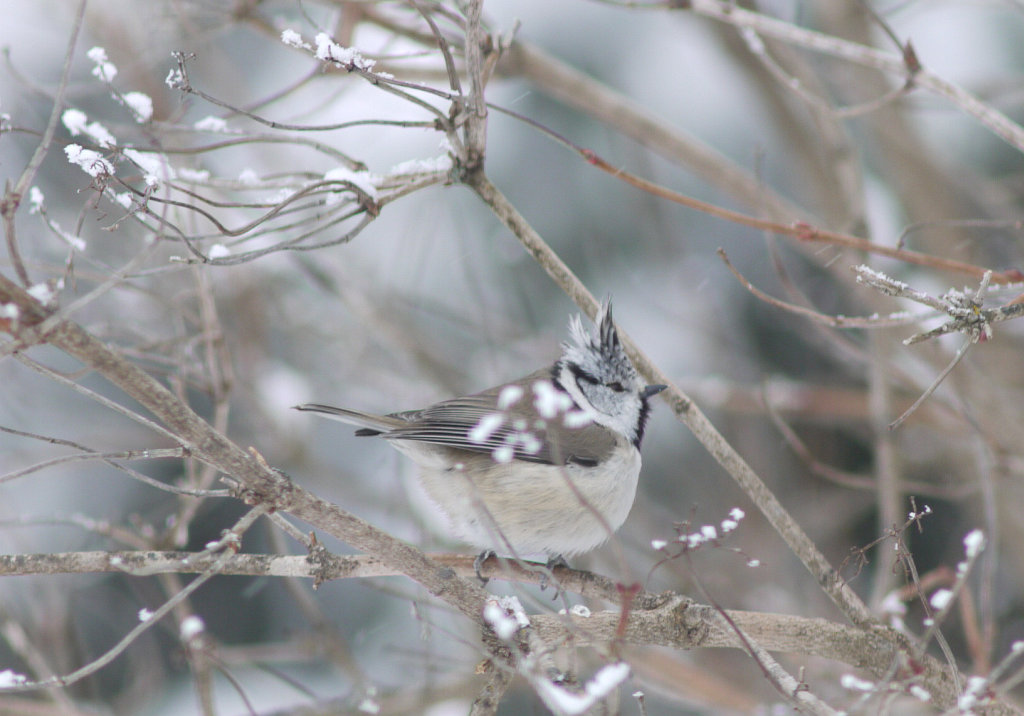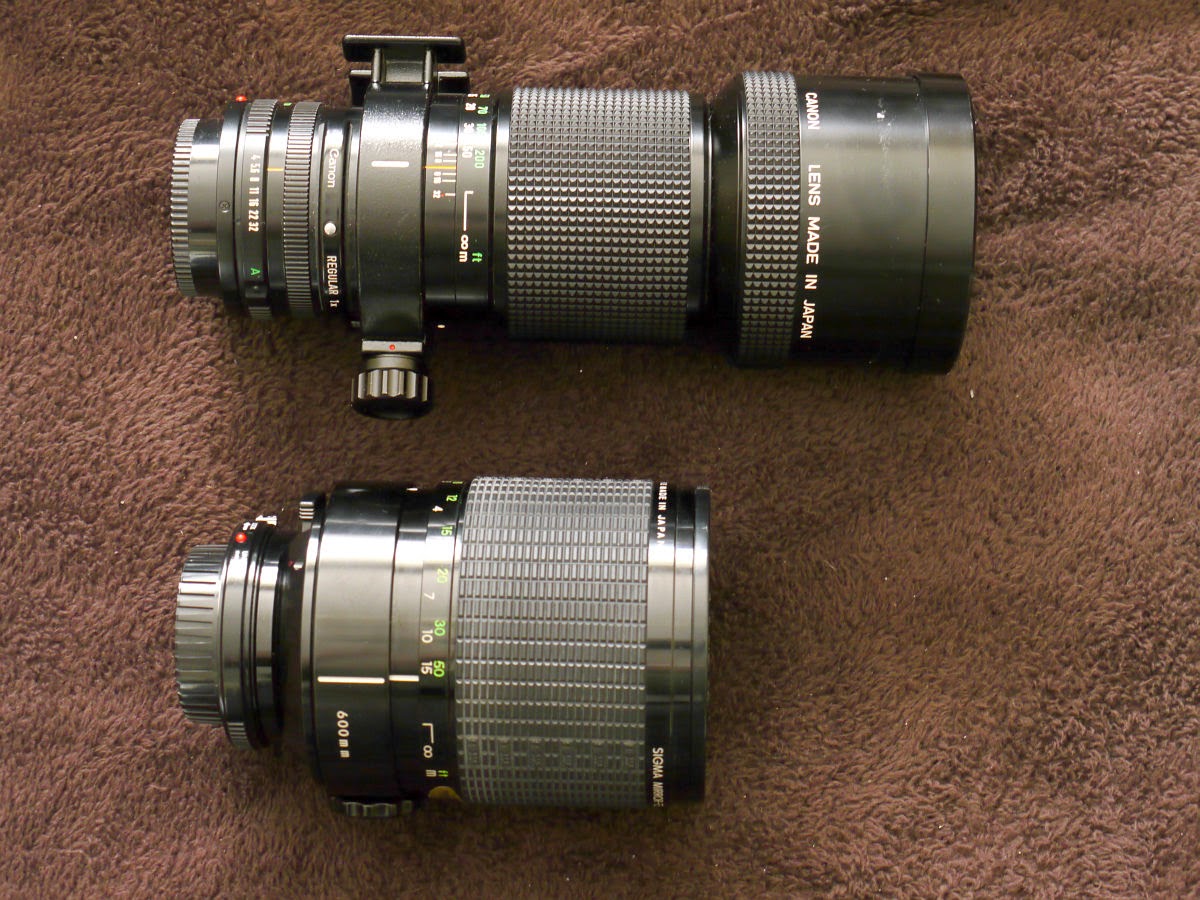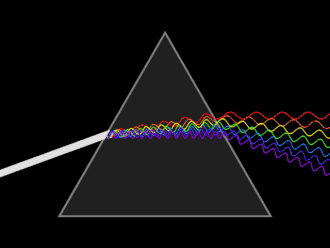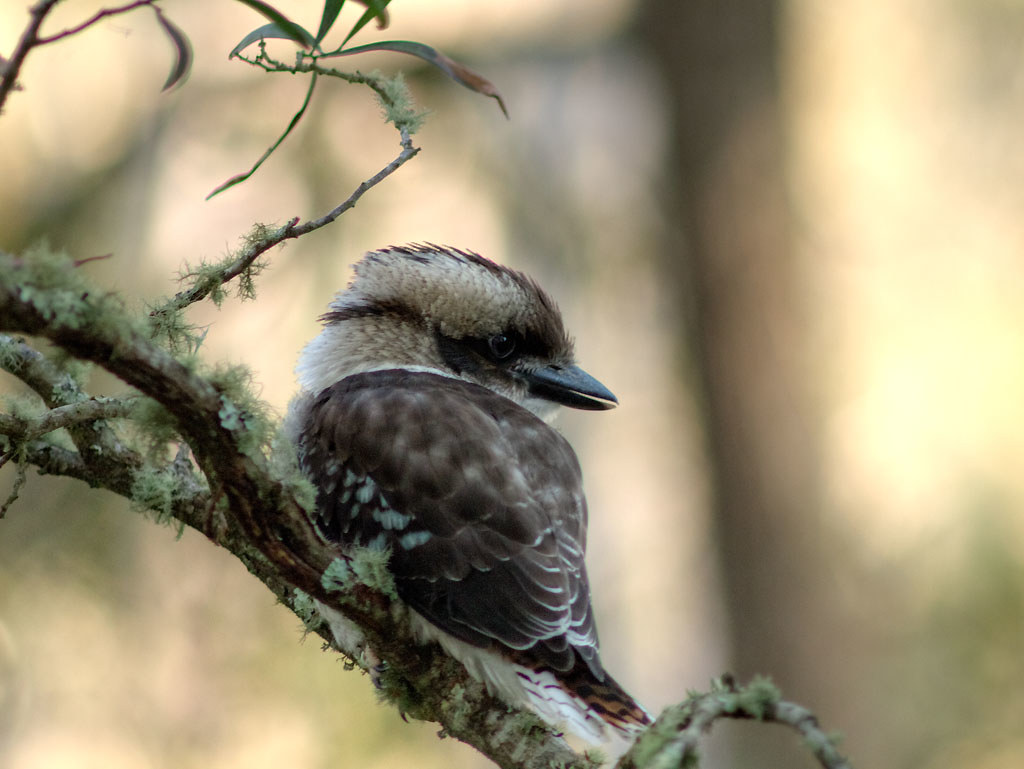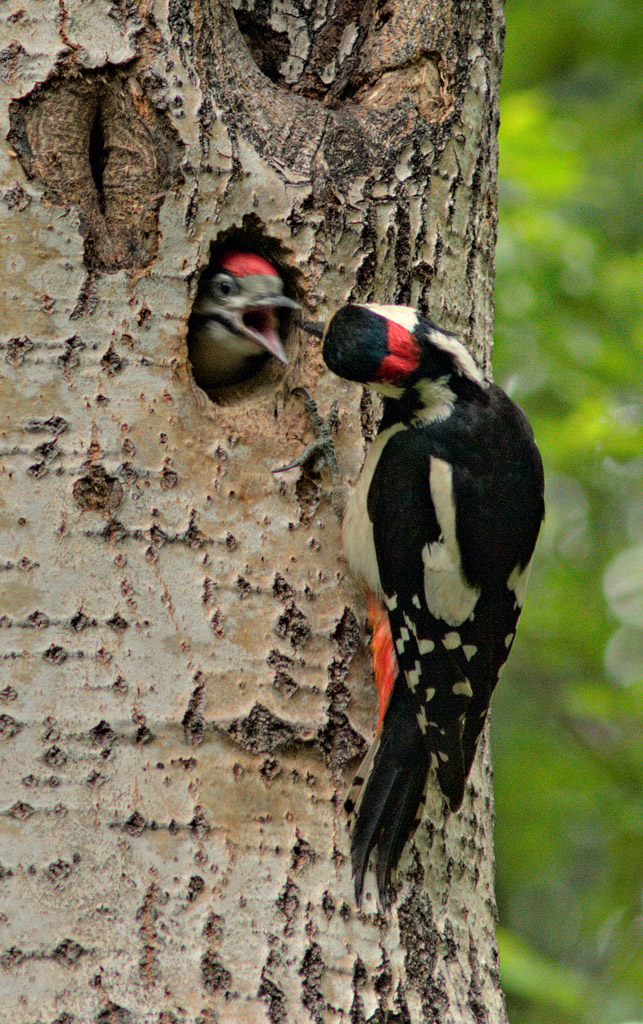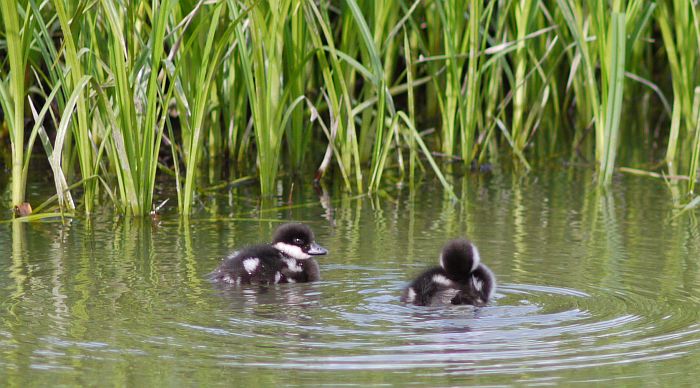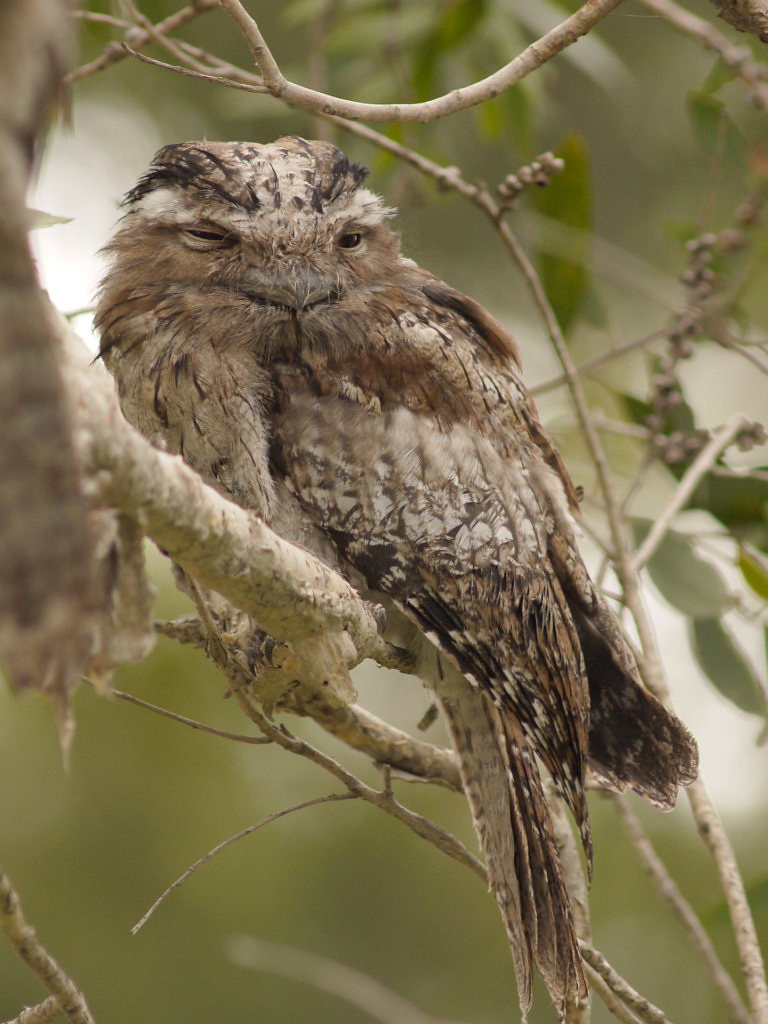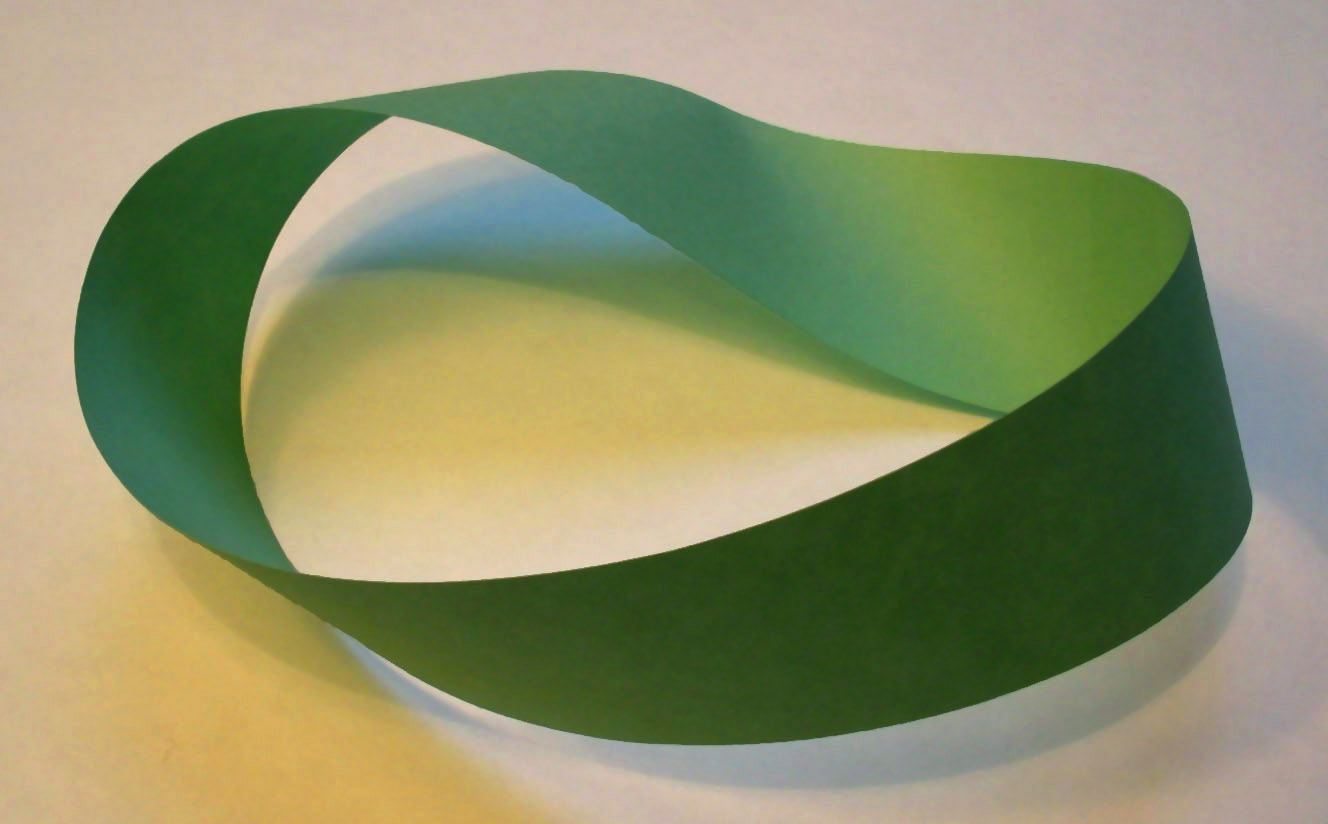Its easy for us to appreciate what is essentially shoved in our faces for us to see in daily life, however the minuscule and insignificant (to the eye) often conceals a beauty.
My Mum loved "Spanish Moss" ... I grew up knowing it only as "Father Christmases Whiskers", she had it hanging off trees in the back yard (with the orchids). This is it in the picture below.
It is an epiphyte which seems to do well enough out in the backyard without any care or attention from me.
I thought it might be nice to hang some off a hook in the bathroom, where it may do "better" given the daily "air moisture" from having a shower. So I put a bit of it on the hook by the window and went about my business (admiring it occasionally). I noticed a few days ago that it had something I've never seen before growing on it ...
and to my eyes it looked like a flower of some sort. Its quite tiny and putting on my glasses (God I hate getting old, well God, while we're talking I hate a number of the other things you've done too) saw that it was indeed flower like.
So I whacked on my 50mm lens onto my extension tubes and took some shots.
Its quite beautiful when you get in closer isn't it
Friday, 31 October 2014
Sunday, 26 October 2014
the Roulettes
Yesterday (well and today too) we had the Gold Coast 600 race (because we lost the Indy har ha ha ha) and as part of the circus we also had the Roulettes doing an air show at the start of the "big race".
I happen to live quite close to where the event is (Main Beach , Gold Coast) and so get a great view of it all.
Even better I live on top of a hill in the area and get an excellent "back row grandstand" overview of it.
I have found in the past that my Canon FD 300mm f4 lens does a fantastic job of aircraft at that range. The shot to the left here is "straight out of the camera" with no cropping to make my lens seem to reach further.
Given that its a 70's mechanical camera lens whacked onto the front of my GH1 I'm happy. Actually I've had it for a five years now and remain happy with it.
Just by way of comparison, here is a shot showing 100% pixels (its a 4000x3000 pixel image capture, so naturally it won't fit on a 1200 pixel wide screen right?) that top aircraft.
which all things considered (you know, like atmospheric losses {shimmer and such}, it being hand held...) I've got to say that I don't think that you'd get that much better with any other lens no matter how much you spent on it.
My technique for this is to focus on something about half a mile away (hat tip to the UK and American readers, as I usually use metric. ... and yes you can see the difference in focus on something further away at f4) and lock it down with my "rubber band" technique.
I then set in f5.6 so that I can get a DoF that covers almost everywhere the aircraft will be in (its called Hyperfocal Distance). Eg, from this online calculator.
So you can see that the amount of blur will trail off gently as they get further away (further than 2.6 Km anyway by which time the combination of atmosphere and distance will soften that loss). To put a perspective on that graph's "Blur" (which is the Circle of Confusion, excellent tutorial there) the value of 0.01 is the minimum discernable size in a 8x12 print and I reckon that the combination of this lens and camera will not attain such. So vrom 300 meters to 2km it won't really change the image.
Anyway, there's more to a good picture than just sharpness and maths right?
I liked this shot (even though it was further away)
and when pixel peeping you can see heat shimmer is already eroding the quality (no matter what focus or what lens I had, even if I'd had a SciFi Anopticon)
Anyway, some other shots from the day ...
It was nice to see the Roulettes
:-)
I happen to live quite close to where the event is (Main Beach , Gold Coast) and so get a great view of it all.
Even better I live on top of a hill in the area and get an excellent "back row grandstand" overview of it.
I have found in the past that my Canon FD 300mm f4 lens does a fantastic job of aircraft at that range. The shot to the left here is "straight out of the camera" with no cropping to make my lens seem to reach further.
Given that its a 70's mechanical camera lens whacked onto the front of my GH1 I'm happy. Actually I've had it for a five years now and remain happy with it.
Just by way of comparison, here is a shot showing 100% pixels (its a 4000x3000 pixel image capture, so naturally it won't fit on a 1200 pixel wide screen right?) that top aircraft.
which all things considered (you know, like atmospheric losses {shimmer and such}, it being hand held...) I've got to say that I don't think that you'd get that much better with any other lens no matter how much you spent on it.
My technique for this is to focus on something about half a mile away (hat tip to the UK and American readers, as I usually use metric. ... and yes you can see the difference in focus on something further away at f4) and lock it down with my "rubber band" technique.
I then set in f5.6 so that I can get a DoF that covers almost everywhere the aircraft will be in (its called Hyperfocal Distance). Eg, from this online calculator.
So you can see that the amount of blur will trail off gently as they get further away (further than 2.6 Km anyway by which time the combination of atmosphere and distance will soften that loss). To put a perspective on that graph's "Blur" (which is the Circle of Confusion, excellent tutorial there) the value of 0.01 is the minimum discernable size in a 8x12 print and I reckon that the combination of this lens and camera will not attain such. So vrom 300 meters to 2km it won't really change the image.
Anyway, there's more to a good picture than just sharpness and maths right?
I liked this shot (even though it was further away)
and when pixel peeping you can see heat shimmer is already eroding the quality (no matter what focus or what lens I had, even if I'd had a SciFi Anopticon)
Anyway, some other shots from the day ...
It was nice to see the Roulettes
:-)
Saturday, 18 October 2014
Past its Prime?
Over the years discussion on the benefits / penalties for using a mirror lens (or Catadioptric lens) just "keeps on keeping on".
The reasons for this are the obvious attraction of having that extra reach of 600mm when taking photos of small things (often birds) at a distance at insanely cheap prices, also that they weigh less is an additional bonus. When one can't get closer the appeal of the extra focal length is just hard to dismiss.
Discussion on this has usually revolved around those who have used them making observations (to the negative) while those who have not used them remain in the wishful thinking stage.
Back in the daze of film there were limitations which more or less do not exist today, one such limitation is the issue of "enlargement". If you wanted to make a print (say 8x10) and you wanted things to be magnified even more (or what is called cropping) you simply had to extend the enlarger further away from the paper or use a different enlarging lens which was itself more telephoto (yes it works the same both ways, in camera : in darkroom). This always resulted in contrast losses (among many other losses) and thus a difficulty getting a good print.
Thus, and perhaps I'm hinting at the conclusion already, there was the appeal / need for using a longer lens when you actually wanted a longer lens.
I sorta expected this outcome but I wanted to "get it out of my system", as well as to present the observations in a meaningful and more thorough manner than I've seen. Perhaps it will help others if they can see.
So the main use of such a lens for me is normally birds, like this little guy:
... clearly with bloody small birds more reach is really on the wish list.
The diameter of the aperture of a 300mm f4 lens (at f4) is exaclty the same as the diameter of a 600mm lens at f8. Thus when cropping the guts out and upscaling the DoF is more or less the same. NB the 300mm does not have a shallower DoF than a cropped into 600mm 300mm.
I find that with respect to the image quality, the optics of the magnification are just not there, might be this lens, but that is not supported by what I see on the web. Essentially magnification can be done by one set of maths or by another set of maths.
Bottom line: get a good quality 300mm f4 refracting lens (you know, the normal ones) and upscale in software as needed.
The differences in the lenses (well the refracting 300mm and the mirror 600mm) are like this:
The weights are:
The basic exposure facts are that using the 300mm f4 at f4 I can get an exposure of 2000th of a second while with the 600mm f8 at f8 I'll be needing 500th ... that's really a tight number and even assuming a solid tripod bloody small birds are usually twitchy ... and subject movement is not something which any wanky Image Stabilization system is going to help with (see here).
pass me a nail for the coffin on the mirror lens.
So, planning around birds, I worked at 8 meters (to my American readers; you can do the conversions to feet and shoes as I'm too slack to do it) which is about as close as I can (without heaps of prep) get to a good shot of bloody small bird.
300mm f4 @ f4
nice and sharp ... good detail shutter = 1/2000th of a sec
600mm @ f8 (and f8's all you get btw...)
Well the 600mm sure looks like it delivers twice the magnification (who'd a thought) but of course it being f8 we are now at 1/500th of a sec. I can assure you that even while attempting to focus (with my EVF zoomed in of course) I could see the problems with the image softness and the effects of such optical magnification on the DoF). So lets look at the:
FD300mm @ f4 cropped to effectively 600mm
Well shit a brick but that's clearer and sharper even at this size isn't it. (by the way, I spent most of yesterday taking images and re-taking images to confirm I'm not going spakko and making mistakes in focus or whatever).
However the astute will observe that there is some chromatic distortions on the branch that's out of focus over to the left at the back ... its purply on the FD lens while has no such colour casts on the Sigma.
The out of focus areas are showing some "colour fringing" (shit I hate that term) which is essentially caused by the fact that lenses bend light (refraction) and mirrors bounce it (reflection).
Think of the Pink Floyd album "Dark Side of the Moon).
Its a fact of optics, and generally lens makers go to to great effort to fix this issue.
BTW lenses which manage to focus red and violet together are called APO or Apohromatic. Get deep pockets for such lenses in longer focal lengths.
Normally a stop down a wee bit (say f5.6) will fix many such ills...
FD300mm @ f5.6 cropped to effectively 600mm
Even sweeter again. I think its cleared that chromatic aberration up a little bit, but man its REALLY cleared up the image. And we still got a shutter speed of 1/1000th of a second.
So to me at this point, for WWW delivery its clearly better to use the 300mm f4 and crop it. My camera is 4000x3000 pixels, and so one doesn't even need an upscale to do this. Just cropping is plenty.
Prints (unlike the web) need more pixels, an 8x10 printed to 300dpi will need 3000 pixels in length. Because there is always some bleeding of pixels in prints (and not on screens) I normally pre-view my images at 50% enlargement not the typical pixel peeping 100% ... I figure that if I can't see it at 50% on the screen then I won't see it on the print.
This is what the 50% pixel view of a center portion of the 600 image looks like
Thts's not pretty ... so now lets push the image taken from the 300mm and look at 100% pixels and see what raw materials we get:
300mm @ f4
wow ... totally sharper in the center of the flower, in fact totaly sharper everywhere.
Ok, you didn't have to fuss and fiddle with focus on the 600mm Mirror Lens like I did, so you didn't get to see how the image went in and out of horrible showing just the sorts of distortions seen here on things just out of the focal plane. This may look to some like motion blur, but if you look around at some of the other factors you can see that its not totally consistent with shake (which usually takes a vector).
So the 300mm @ f5.6
well ... that's really an improvement. At f4 its better than the 600 by a margin, but at f5.6 its scorchingly better. So now we have even better raw material available here for a bicubic upscale. This is streets ahead of the 600mm mirror lens and we've still got a shutter speed that's twice as fast as the 600mm (in case our bird twitches ... and you know he want's to)
Hand me another nail for the 600mm mirror lens coffin will you please?
First, lets just do that upscale and see (600mm on top, upscaled 300mm on bottom):
Far less detail in the center of the flower ...well everywhere really.
So then with our pixel peeping gum boots already on viewing at 100% (same image order as above)
I see texture in the flower petals on the upscaled 300mm f5.6, but not on the 600mm
hmmm ... another nail for the mirror lens coffin it seems.
Then someone may ask "well what if you used ISO to increase the shutter speed on the 600mm capture, that could be vibration blur". Personally I already see enough fine detail in the red parts of the flower petal to make it obvious to me that there is no camera shake ... but what the hell, its a fair question, so here it is:
another nail please ... and can you get the nail bucket while you're there please?
Of course with the increase in ISO (to get that speed) what happens to details? Well lets step back to 50% and have a look at the RED channel noise.
Oh dear ... more noise and (of course) an erosion of detail caused by the increase in ISO (well of course).
So what you speed may pick up with increase in ISO (to equal the shutter speed of the faster 300) you'll loose even more detail than you're already loosing anyway.
Another nail ...
Olympus also makes a lovely 300mm f4.5 lens which I have owned and found it equal to the FD300, its also around for about the same money (between US$200 and US$120). I have a comparison of the only differences worth mentioning between those two lenses here.
You got the bucket of nails didn't you? Cos I think we're about done here and can hammer the lid closed.
Perhaps back in the daze of film when attempting to do optically what we now can do digitally (different maths path for the same objective) there was a better case for the 600mm catadioptric. Especially given that a 600mm reflecting lens is and was huge and expensive. To me nowadays there is really no advantage in the mirror 600mm over the refracting 300mm f4.
Sure the Sigma is a bit smaller but since you'll definitely need a tripod using it the minor weight advantage evaporates quickly. Remember that for us with micro4/3 a 300mm is effectively a 600mm for the full frame guys, which means we are already pushing the limits of the optics (more so with legacy optics). So having an effective (to full frame) 1200mm lens is really amazing stuff.
However the ability to now do upscales in photoshop means that I can use my 300mm and make it effectively a 600mm and gain many of its other benefits such as having an aperture to stop down and alter the image appearance as well as the 2 stop faster aperture it has.
In summary the Coffin Nails were:
To me a prime lens is all about having the maximum image quality without compromise. As I've just shown in the digital age the catadioptric (mirror) lenses are a prime lens which in my view is past its prime. Perhaps there may be some newer lenses which will be better than this, perhaps the Canon or Olympus brand catadioptric lenses do better ... if you have one why not contact me and or write it up your self.
What I have not discussed here is the handling of the lens and the difficulty in focusing with the lens not on a tripod. Personally I've been able to hand hold and get good shots with my FD300 (and my OM300) - even bearing such upscales as here. Clearly my hand holding technique is adequate.
So, now you can tick mirror lenses off your list :-)
Lastly some shots with my FD300mm, which I am somehow more happy with after doing this. In the main the images below are hand held (or monopod).
Young Kookaburra (just out of the nest)
Woodpecker in Finland
Ducklings (Telkka)
Tawny Frogmouth
Plovers with a newly hatched chick
The reasons for this are the obvious attraction of having that extra reach of 600mm when taking photos of small things (often birds) at a distance at insanely cheap prices, also that they weigh less is an additional bonus. When one can't get closer the appeal of the extra focal length is just hard to dismiss.
Discussion on this has usually revolved around those who have used them making observations (to the negative) while those who have not used them remain in the wishful thinking stage.
Back in the daze of film there were limitations which more or less do not exist today, one such limitation is the issue of "enlargement". If you wanted to make a print (say 8x10) and you wanted things to be magnified even more (or what is called cropping) you simply had to extend the enlarger further away from the paper or use a different enlarging lens which was itself more telephoto (yes it works the same both ways, in camera : in darkroom). This always resulted in contrast losses (among many other losses) and thus a difficulty getting a good print.
Thus, and perhaps I'm hinting at the conclusion already, there was the appeal / need for using a longer lens when you actually wanted a longer lens.
I sorta expected this outcome but I wanted to "get it out of my system", as well as to present the observations in a meaningful and more thorough manner than I've seen. Perhaps it will help others if they can see.
So the main use of such a lens for me is normally birds, like this little guy:
... clearly with bloody small birds more reach is really on the wish list.
quick summary
I've done all this on micro43, which is in my opinion the best system to test this on. Without the ability to use the EVF (I'm using a GH1, but your OMD would be the same) to magnify the image from the sensor to ensure critical accurate focus you will only get worse results than I've got here. Just forget about this whole idea if you are still in the 20th century with Optical view finders on winky dink DSLR sized viewfinder optics - its just not accurate enough.The diameter of the aperture of a 300mm f4 lens (at f4) is exaclty the same as the diameter of a 600mm lens at f8. Thus when cropping the guts out and upscaling the DoF is more or less the same. NB the 300mm does not have a shallower DoF than a cropped into 600mm 300mm.
I find that with respect to the image quality, the optics of the magnification are just not there, might be this lens, but that is not supported by what I see on the web. Essentially magnification can be done by one set of maths or by another set of maths.
- One set of maths is the maths involved in making the optical enlargement.
- The other set of maths is that in the bicubic upscales in software.
Bottom line: get a good quality 300mm f4 refracting lens (you know, the normal ones) and upscale in software as needed.
OK ... enough blabbering show me something
I took these images using my GH1 on a tripod and with a cable release. I picked a fully sunny day to ensure that I could use the best ISO possible for details and used manual control to ensure that my resulting exposures would be consistent and easily dissectable.The differences in the lenses (well the refracting 300mm and the mirror 600mm) are like this:
The weights are:
- Canon = 1.11kg
- Sigma = 767g
The basic exposure facts are that using the 300mm f4 at f4 I can get an exposure of 2000th of a second while with the 600mm f8 at f8 I'll be needing 500th ... that's really a tight number and even assuming a solid tripod bloody small birds are usually twitchy ... and subject movement is not something which any wanky Image Stabilization system is going to help with (see here).
pass me a nail for the coffin on the mirror lens.
So, planning around birds, I worked at 8 meters (to my American readers; you can do the conversions to feet and shoes as I'm too slack to do it) which is about as close as I can (without heaps of prep) get to a good shot of bloody small bird.
300mm f4 @ f4
nice and sharp ... good detail shutter = 1/2000th of a sec
600mm @ f8 (and f8's all you get btw...)
Well the 600mm sure looks like it delivers twice the magnification (who'd a thought) but of course it being f8 we are now at 1/500th of a sec. I can assure you that even while attempting to focus (with my EVF zoomed in of course) I could see the problems with the image softness and the effects of such optical magnification on the DoF). So lets look at the:
FD300mm @ f4 cropped to effectively 600mm
Well shit a brick but that's clearer and sharper even at this size isn't it. (by the way, I spent most of yesterday taking images and re-taking images to confirm I'm not going spakko and making mistakes in focus or whatever).
However the astute will observe that there is some chromatic distortions on the branch that's out of focus over to the left at the back ... its purply on the FD lens while has no such colour casts on the Sigma.
The out of focus areas are showing some "colour fringing" (shit I hate that term) which is essentially caused by the fact that lenses bend light (refraction) and mirrors bounce it (reflection).
Think of the Pink Floyd album "Dark Side of the Moon).
Its a fact of optics, and generally lens makers go to to great effort to fix this issue.
BTW lenses which manage to focus red and violet together are called APO or Apohromatic. Get deep pockets for such lenses in longer focal lengths.
Normally a stop down a wee bit (say f5.6) will fix many such ills...
FD300mm @ f5.6 cropped to effectively 600mm
Even sweeter again. I think its cleared that chromatic aberration up a little bit, but man its REALLY cleared up the image. And we still got a shutter speed of 1/1000th of a second.
So to me at this point, for WWW delivery its clearly better to use the 300mm f4 and crop it. My camera is 4000x3000 pixels, and so one doesn't even need an upscale to do this. Just cropping is plenty.
OK, lets look more closely
Prints (unlike the web) need more pixels, an 8x10 printed to 300dpi will need 3000 pixels in length. Because there is always some bleeding of pixels in prints (and not on screens) I normally pre-view my images at 50% enlargement not the typical pixel peeping 100% ... I figure that if I can't see it at 50% on the screen then I won't see it on the print.
This is what the 50% pixel view of a center portion of the 600 image looks like
Thts's not pretty ... so now lets push the image taken from the 300mm and look at 100% pixels and see what raw materials we get:
300mm @ f4
wow ... totally sharper in the center of the flower, in fact totaly sharper everywhere.
Ok, you didn't have to fuss and fiddle with focus on the 600mm Mirror Lens like I did, so you didn't get to see how the image went in and out of horrible showing just the sorts of distortions seen here on things just out of the focal plane. This may look to some like motion blur, but if you look around at some of the other factors you can see that its not totally consistent with shake (which usually takes a vector).
Cleaning things up optically
Since you (should) know that stopping down a stop covers some evils and reveals a better image from the this lens than its "hot chikz-over-the-bonnet advertising special highly-desireable-fully-open aperture" f2.8 version (which still btw clears up by stopping down). Note, this is of course something you can't do with the Mirror Lens: its f8 and that's all its is babySo the 300mm @ f5.6
well ... that's really an improvement. At f4 its better than the 600 by a margin, but at f5.6 its scorchingly better. So now we have even better raw material available here for a bicubic upscale. This is streets ahead of the 600mm mirror lens and we've still got a shutter speed that's twice as fast as the 600mm (in case our bird twitches ... and you know he want's to)
Hand me another nail for the 600mm mirror lens coffin will you please?
The actual upscale
Ok, lets get our pixel-peeping gum boots on and dig around in the dirt for a bit for those who aren't already convince or have a few "what if you .." questions.First, lets just do that upscale and see (600mm on top, upscaled 300mm on bottom):
Far less detail in the center of the flower ...well everywhere really.
So then with our pixel peeping gum boots already on viewing at 100% (same image order as above)
I see texture in the flower petals on the upscaled 300mm f5.6, but not on the 600mm
hmmm ... another nail for the mirror lens coffin it seems.
Then someone may ask "well what if you used ISO to increase the shutter speed on the 600mm capture, that could be vibration blur". Personally I already see enough fine detail in the red parts of the flower petal to make it obvious to me that there is no camera shake ... but what the hell, its a fair question, so here it is:
another nail please ... and can you get the nail bucket while you're there please?
Of course with the increase in ISO (to get that speed) what happens to details? Well lets step back to 50% and have a look at the RED channel noise.
Oh dear ... more noise and (of course) an erosion of detail caused by the increase in ISO (well of course).
So what you speed may pick up with increase in ISO (to equal the shutter speed of the faster 300) you'll loose even more detail than you're already loosing anyway.
Another nail ...
Costs:
Bang for buck is an important consideration too. I paid US$120 (or something like that) for my FD300f4, and I paid US$120 for my Sigma 600mm f8 ... so the costs are about equal.Olympus also makes a lovely 300mm f4.5 lens which I have owned and found it equal to the FD300, its also around for about the same money (between US$200 and US$120). I have a comparison of the only differences worth mentioning between those two lenses here.
You got the bucket of nails didn't you? Cos I think we're about done here and can hammer the lid closed.
Conclusion
Perhaps back in the daze of film when attempting to do optically what we now can do digitally (different maths path for the same objective) there was a better case for the 600mm catadioptric. Especially given that a 600mm reflecting lens is and was huge and expensive. To me nowadays there is really no advantage in the mirror 600mm over the refracting 300mm f4.
Sure the Sigma is a bit smaller but since you'll definitely need a tripod using it the minor weight advantage evaporates quickly. Remember that for us with micro4/3 a 300mm is effectively a 600mm for the full frame guys, which means we are already pushing the limits of the optics (more so with legacy optics). So having an effective (to full frame) 1200mm lens is really amazing stuff.
However the ability to now do upscales in photoshop means that I can use my 300mm and make it effectively a 600mm and gain many of its other benefits such as having an aperture to stop down and alter the image appearance as well as the 2 stop faster aperture it has.
In summary the Coffin Nails were:
- such a lack of sharpness even its extra length does not cover its arse
- slower shutter speed (leading to potential subject movement blur) applying sufficient ISO to solve the 2 stop loss of light erodes detail more
- minor weight advantage lost when you need to use a tripod (or attempt to handhold and lose even more)
To me a prime lens is all about having the maximum image quality without compromise. As I've just shown in the digital age the catadioptric (mirror) lenses are a prime lens which in my view is past its prime. Perhaps there may be some newer lenses which will be better than this, perhaps the Canon or Olympus brand catadioptric lenses do better ... if you have one why not contact me and or write it up your self.
What I have not discussed here is the handling of the lens and the difficulty in focusing with the lens not on a tripod. Personally I've been able to hand hold and get good shots with my FD300 (and my OM300) - even bearing such upscales as here. Clearly my hand holding technique is adequate.
(sidebar: manynewbiesexperienced photographers on the internet say they can't focus and hand hold because the image jumps all over the place. The answer to their question is this "Yes, it is you. Yes, you do need to work on your technique. You can learn to observe the target in the image and not be seeing the frame. No you can't hand hold a 300mm tele and focus off the back of the screen like a girl with an iPhone. Yes you can learn it if you put a little effort into it and adjust your technique)
So, now you can tick mirror lenses off your list :-)
Lastly some shots with my FD300mm, which I am somehow more happy with after doing this. In the main the images below are hand held (or monopod).
Young Kookaburra (just out of the nest)
Woodpecker in Finland
Ducklings (Telkka)
Tawny Frogmouth
Plovers with a newly hatched chick
Monday, 13 October 2014
my personal (mental) Möbius strip
Since Anita died I find myself pondering the same questions over and over again, the arguments seem to be "circular" and despite moving from one point to another I end up with dependencies that are essentially begging the same questions.
Unlike my story of the dust mites on the bolt thread I have come to wonder if I am indeed spiraling around in a general direction or if I am walking on a mental Möbius strip.
Perhaps the issue is that I lack the mental capacity to actually understand the problem.
Perhaps it is that I lack the information / evidence / data to advance my situation.
I can find people who can tell me there is a God, I can find people who tell me that there is life after death and I can find people who will tell me that all of that is a nonsense. No lacking in people convicted of diverse and mutually exclusive ideas out there to choose from that's for sure.
Indeed it is entirely possible that (say due to the quantum universe in which we see manifest) it is entirely an untestable proposition, and that no proof can ever be had. Perhaps it is such that the proof is beyond the capacity of humans (or at least me) to grasp. This article suggests that "incomprehensible to human" proofs may exist:
So if such a proof can only be comprehended by a handful of the humans on the planet, then it becomes quite close to an act of faith for the rest of us to believe them. Which of course sort of brings me back along the Möbius strip to St Augustine again:
Of that point I have no doubt.
Unlike my story of the dust mites on the bolt thread I have come to wonder if I am indeed spiraling around in a general direction or if I am walking on a mental Möbius strip.
Perhaps the issue is that I lack the mental capacity to actually understand the problem.
Perhaps it is that I lack the information / evidence / data to advance my situation.
I can find people who can tell me there is a God, I can find people who tell me that there is life after death and I can find people who will tell me that all of that is a nonsense. No lacking in people convicted of diverse and mutually exclusive ideas out there to choose from that's for sure.
Indeed it is entirely possible that (say due to the quantum universe in which we see manifest) it is entirely an untestable proposition, and that no proof can ever be had. Perhaps it is such that the proof is beyond the capacity of humans (or at least me) to grasp. This article suggests that "incomprehensible to human" proofs may exist:
There are an infinite number of finite simple groups but a finite number of families to which they belong. Mathematicians have been studying groups since the 19th century, but the Enormous Theorem wasn't proposed until around 1971, when mathematician Daniel Gorenstein of Rutgers University in New Jersey devised a plan to identify all the finite simple groups, divide them into families and prove that no others could exist.
Gorenstein and his hundreds of collaborators spent a decade working on the proof. By 1981, Gorenstein could see the light at the end of the tunnel, though a few hurdles remained. The proof remained incomplete until the 2004 publication by Aschbacher and Smith, which completed the proof. It identified all the families – and showed no others could exist.
Solomon estimates that only a few mathematicians in the world (including Aschbacher) understand the complete proof.
So if such a proof can only be comprehended by a handful of the humans on the planet, then it becomes quite close to an act of faith for the rest of us to believe them. Which of course sort of brings me back along the Möbius strip to St Augustine again:
"Nisi credideritis, non intelligetis"Who knows, there may well be a teapot in the orbit between Earth and Mars. But personally I don't give a fuck about Russell's teapot, I only care about Anita, my love for her and knowledge of the love she had for me.
Of that point I have no doubt.
Wednesday, 8 October 2014
the Blood Moon
Hi
downunder we (in theory) got to witness the lunar eclipse tonight. Well, the clouds made it difficult (read impossible) to do a sequence of the moons phases with any sort of regularity, so with that excuse made, here are some shots from tonight.
for reference, the full moon is by definition in full sunlight, so its a daylight exposure, or about 250th f4 @ ISO100 ... then
then
hmmm getting darker
and the redness starts to appear (and man does the shutter speed lengthen)
totality, where its really dark
and something nice to show off the colours
sorry its a bit blurry, but you know, it is moving at about 3600Km/H right ... and at this point it was a 1 second exposure f4 @ ISO 1600
So a quick and dirty sequence
:-)
downunder we (in theory) got to witness the lunar eclipse tonight. Well, the clouds made it difficult (read impossible) to do a sequence of the moons phases with any sort of regularity, so with that excuse made, here are some shots from tonight.
for reference, the full moon is by definition in full sunlight, so its a daylight exposure, or about 250th f4 @ ISO100 ... then
then
hmmm getting darker
and the redness starts to appear (and man does the shutter speed lengthen)
totality, where its really dark
and something nice to show off the colours
sorry its a bit blurry, but you know, it is moving at about 3600Km/H right ... and at this point it was a 1 second exposure f4 @ ISO 1600
So a quick and dirty sequence
:-)
Sunday, 5 October 2014
emotional masala
every day I just want to drop something (but it is me who will have to clean it up, so I don't)
every day I want to tear things apart (but it is me who will have to fix them, so I don't)
every day I want to scream out loud (some days I do)
every day I look at her works (and cherish them)
some days I laugh out loud at something ridiculous which I suddenly see as funny
less days than I have before I cry
There is so much in my life to remind me of her ... of us ... of who we were together
knowing that it can be worse somehow does not make it feel less bad
knowing that what we had was rare and special still does not substitute for her loss.
I feel that promises given freely are none the less binding. I do not regret those promises, I would not trade having had our life together, for that defines so much of who I am. I just lament the loss.
Bonds are in some ways the opposite of freedom. So while I know I will never be free, I don't feel the desire to struggle to break that bond, for it was in those ties that I found love.
I feel simply that I love her and lament her loss.
Just like guys like this understand their loss. Loss of something which they too would never wish they had never had.
an understanding that what is gone is not coming back
doing their best to adjust to life without part of themselves.
every day I want to tear things apart (but it is me who will have to fix them, so I don't)
every day I want to scream out loud (some days I do)
every day I look at her works (and cherish them)
some days I laugh out loud at something ridiculous which I suddenly see as funny
less days than I have before I cry
There is so much in my life to remind me of her ... of us ... of who we were together
knowing that it can be worse somehow does not make it feel less bad
knowing that what we had was rare and special still does not substitute for her loss.
I feel that promises given freely are none the less binding. I do not regret those promises, I would not trade having had our life together, for that defines so much of who I am. I just lament the loss.
Bonds are in some ways the opposite of freedom. So while I know I will never be free, I don't feel the desire to struggle to break that bond, for it was in those ties that I found love.
I feel simply that I love her and lament her loss.
Just like guys like this understand their loss. Loss of something which they too would never wish they had never had.
an understanding that what is gone is not coming back
doing their best to adjust to life without part of themselves.
Subscribe to:
Comments (Atom)











